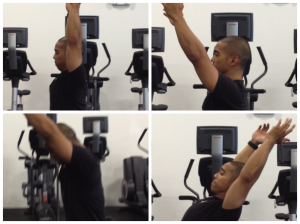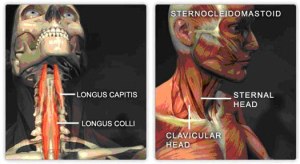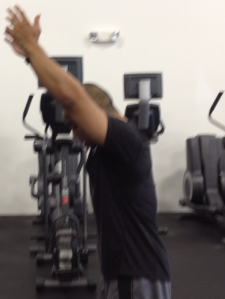Ninjas, gymnasts, and Cirque du Soleil. What do they all have in common? Besides all things that I wish was or something I wish I partook in, they all utilize amazing forms of acrobatics and movements in their chosen art. The one movement I will focus on today is the handstand, and achieving the handstand push-up.
Before that, if you didn’t catch the first two parts of this series, find the following links to the previous portions of this series here and re-learn yo’self:
The Push-Up: Part 1 – Are You Doing These Common Push-Up Errors?
The Push-Up: Part 2 – Progressions
The movement can be broken down into two different aspects: first achieving the position of the handstand, and getting used to being upside down, and secondly moving through a full range of motion.
Before performing a handstand push-up, let’s begin with this easy test. No, not like a Karate Kid test, where I make you paint my fence and wash my deck for a few days. It is a lot easier than that.
It is a simple test of raising the arms overhead.
If you were to take a picture from the side, what would you look like?

Proper Alignment
[Noticeable misalignment of hands. Reflects my years of dancing; ie right rotation is more prominent than left rotation!]
Ideally the above picture will have the hands aligned, along with a traceable straight line from the hands through the ears, shoulders, and straight down through to the feet [not shown although I am short enough to include it in one whole photograph ;o)].
So with that in mind, here are some compensations that could occur during shoulder flexion that I often encounter regularly with athletes and clients (besides the obvious one above!).
Cervical Flexion
In this case, the athlete clearly lacks the mobility to attain “true” shoulder flexion or overhead position, and thus “makes up” for it by pushing their head through their shoulders. In regards to a handstand, the head will have a tendency to “poke forward” or through to provide a “pseudo” handstand push-up “lockout”, when in reality you are still missing that 20-30° of motion at the top of full extension.

Matt Siniscalchi provides a great walk through of how to train the deep cervical flexors and the implications in regards to a training program. Despite the specificity of his article, similar threads can be drawn from his blogpost in regards to injury prevention, as an unstable position for the head in the handstand push-up will draw inefficient movement down the body’s anatomy lines.

Lumbar (Hyper)Extension
In individuals who tend to stand for lengthy periods of time, (dancers and athletes), this position may present itself when bringing the arms overhead. Whether it is due to their posture (lengthy amounts of time without sitting down), or the fact that they look like they are always riding a roller coaster, this can be alleviated through several means.
Namely, lumbar extension may present itself due to the lats, rhomboids, and/or traps being stronger than the abdominals, so activating or strengthening the anterior core will help facilitate them out of this pattern.
Stiff Latissimus Dorsi and/or Pec Major/Minor

Very similar to the above pattern, except instead of the permanent roller coaster look, the athlete will look like they are looking for someone to give them a high five. Analogies aside, this movement pattern could be due to a result of stiff tissue quality in our athletes that are active, whether that is due to overuse or lack of mobility overall is not the issue. This could be due to a lack of healthy tissue extensibility in the internal rotators of the shoulders – lats, pecs, and subclavius are many of the usual suspects in this case.
Lack of Scapular Rotation
Further, this could also be a lack of serratus anterior activation along with everything else. In regards to many people looking immediately at the front to back ratios of pushing to pulling (when you bench, you row!), properly addressing scapular rotation will also include looking at upper trap to lower trap ratios as well. In this case, lower trap may be dominant, and upper trap may be lacking the proper activation. In this case, I’d suggest utilizing this shoulder stability drill.
[youtube=http://www.youtube.com/watch?v=X0Kxe_py3Xs]
Notice when I bring my arms to approximately shoulder height, I begin to shrug as if to recruit the upper trap to help elevate and rotate the scapula.
So without getting extremely geeky into the anatomy of it all, you can begin to see that simply getting your hands overhead is a little more complicated than waving some pom poms and cheering with your favorite cheerleaders!
[youtube=http://www.youtube.com/watch?v=FIfbghHdG1s]
So with all of the above nestled comfortably under your belt, when the heck can you start doing handstand push-ups?
Well, before you start WODing all over the place and crushing handstand push-ups like no one’s bee’s nest, here are some ways to progress into the handstand push-up (assuming you are all bored-ed out with the variety of push-ups from the SECOND PART of this series).
There are plenty of ways to move weight in an overhead position – barbell, kettlebell, dumbbell, or even babies. Barring throwing infants in the air (to make them laugh and giggle of course), I’m a sucker for specificity. This means that if I want to achieve an overhead or handstand position, I’m going to train it in the most specific way possible. So the factors I’m looking for are a closed-chain exercise with hands on the floor, with adequate shoulder flexion, and my feet dangling in the air.
Feet Elevated Yoga Push-Up Series
[youtube=http://www.youtube.com/watch?v=Syl6FTV2hMQ]
While each one of these literal steps can be used within a program for a lengthy amount of time, the thing to appreciate is that health shoulder motion is desirable at all times, ie proper upward rotation of the scapula during the push away from the floor.
The neat thing about performing a yoga push-up in this manner is that while mobility of the shoulder is being encouraged, during the push-up portion stability is being reinforced as you come down to perform the push portion of the lift. A great catch-all exercise that gets more difficult as you increase the height of the box as well.
Wall Supported Handstand Holds
The idea that I want to begin to incorporate with this exercise is the idea of literally being upside down. This fact alone freaks out anyone who isn’t committed to the idea – and that is alright. No one said you have to do anything upside down at all. It just makes you look ninja-awesome is all.

With that being said, it is easy to substitute lumbar extension for an overhead position (re: above lumbar extension pattern), so it is imperative to encourage proper alignment via bracing or a “ribs down” position, as opposed to hanging out on your vertebral and/or lumbar facets.
Aim to hold this exercise for approximately 5-10 seconds as a beginner, and upwards to 30 seconds as you progress with your Karate Kid skills. Further, diaphragmatic breathing is paramount even while upside down – if breathing patterns are all aberrant and whatnot, then this may cause you to get a head rush of blood as all you are doing is breathing through your upper thorax and/or neck/face.
Handstand Push-Ups
And finally, handstand push-ups. After all the trials and tribulations, a perfect handstand push-up will exhibit appropriate scapular rotation, along with adequate amounts of anterior core strength.
In this bottom video, I demonstrate a wall supported handstand push-up, and in the next one I perform a free standing handstand push-up. The second video isn’t perfect however, as my neck comes into play, and there is a questionable depth being used. If anything however, it shows that I myself have much room for improvement!
[youtube=http://www.youtube.com/watch?v=FYEQGhhKVgc]
[youtube=http://www.youtube.com/watch?v=uTtkRs0VUFU]
###
Conclusion
With that, I’ve covered the basics of the push-up, to progressing to more difficult variations, along with now covering the not-so-elusive handstand push-up.
Happy Handstand Push-Ups!
MA



